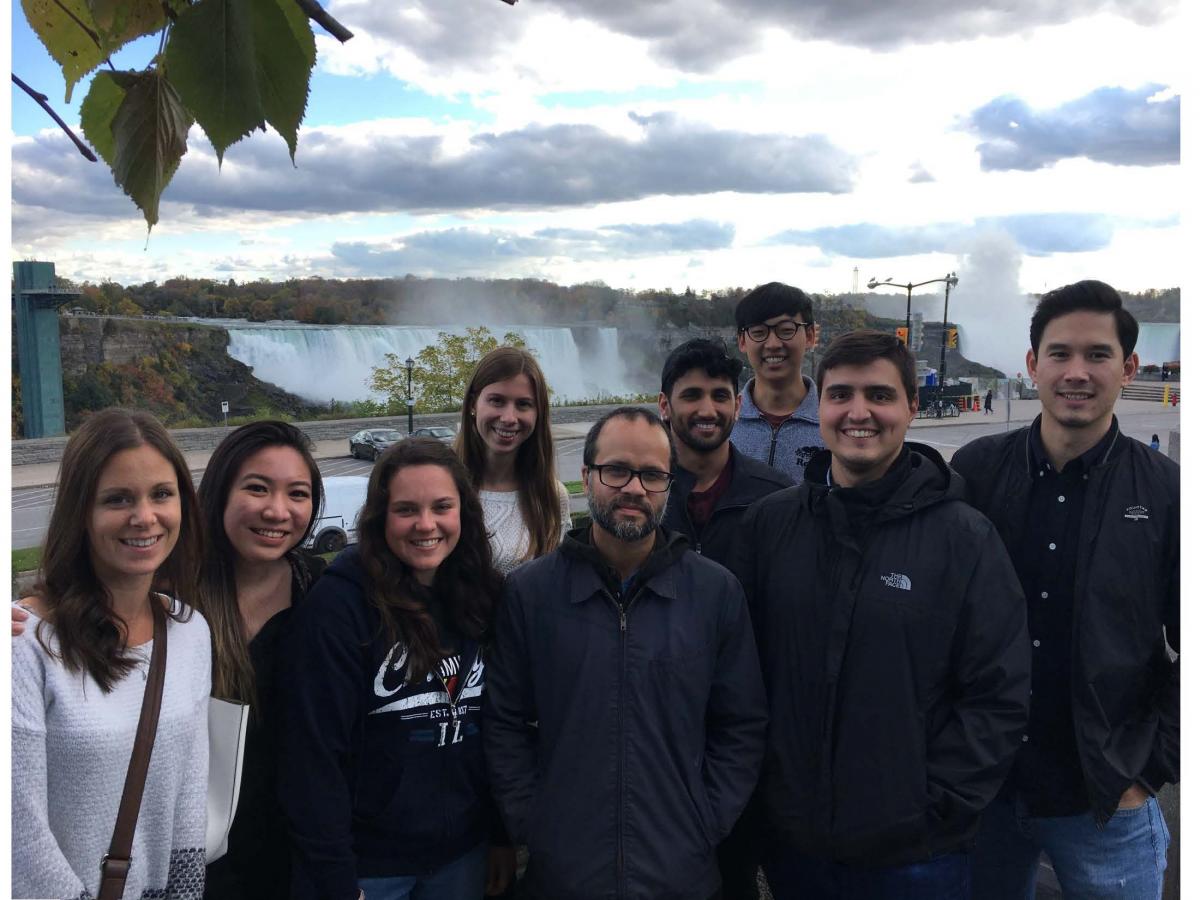Dr. Anthony Clarke

My interest in microbiology began as an undergraduate student at the University of Waterloo. I was pursuing a double honours B.Sc. in chemistry and biology and during the third and fourth years of my program I focused my attention on microbiological systems. My fourth year honours research project concerned a study on the inhibition of β lactamase, the enzyme that renders the β-lactam antibiotics (penicillins, cephalosporins) ineffective and thus representing a major factor of antibiotic resistance. Through this experience, I developed a passion for research in enzymology and so I continued my studies at Waterloo for my doctorate in biochemistry. I was introduced to carbohydrate-active enzymes as a post-doctoral fellow at the Carlsberg Research Centre in Copenhagen, and then as a research associate at the National Research Council in Ottawa. On joining the University of Guelph, I established a research program that integrates biochemical, biophysical, microbiological, and molecular biological techniques to investigate the structure-function relationship of the enzymes that synthesize and lyse the essential bacterial cell wall polymer peptidoglycan and the plant cell wall polymer cellulose, with the major goals of identifying new targets for antibiotic development and the efficient production of cellulosic ethanol, respectively. This multi-disciplinary approach involves collaborations with colleagues at Guelph, across the country, and around the World.
- B.Sc. Waterloo
- M.Sc. Waterloo
- Ph.D. Waterloo
Research in my laboratory concerns investigating the structure and function relationship of enzymes involved in the metabolism of the essential bacterial cell wall polymer peptidoglycan. Peptidoglycan is a heteropolymer of both amino-sugars and short peptides that completely surrounds bacterial cells as a single macromolecule to provide their rigidity and structure. Its biosynthesis occurs in three stages involving the cytoplasm, the cytoplasmic membrane, and the cell wall. Specific reactions in each of these stages have proven to be effective targets for antibiotic therapy, including the inhibition of peptide cross-linking within the cell wall by the ß-lactam class of drugs (penicillins and celphalosporins). Our studies focus on the events within the cell wall with the aim to identify new potential targets for antibiotic development.
The search for new antibiotic targets provide fascinating challenges for experimental research involving a wide range of experimental approaches that span the biochemistry, biophysics, microbiology, molecular biology, and structural biology.
Current areas of emphasis include:
- Structure and function of the lytic transglycosylases, endogenous 'autolysins' that are involved in the biosynthesis and turnover of peptidoglycan, and the insertion of multi-protein complexes through the cell wall, such as flagella, pili, and secretion systems.
- The role of proteinaceous inhibitors of lysozyme in the physiological control of lytic transglycosylases.
- Characterization of the enzyme systems required for the O-acetylation of peptidoglycan in both Gram positive and Gram negative bacteria, using primarily Bacillus anthracis, Staphylococcus aureus and Neisseria gonorrhoeae as model systems.
- High-throughput screening for inhibitors of peptidoglycan O-acetyltransferases and O-acetylesterases
- Determination of X-ray crystal structures of O-acetyltransferases.
- Structural basis for substrate recognition and inhibition of O-acetylpeptidoglycan esterases.
- Sychantha, D., A.S. Brott, C. Jones, and A.J. Clarke (2018) Mechanistic pathways for peptidoglycan O-acetylation and de-O-acetylation. Fronteirs Microbiol. 9:2332.
- Sychantha, D., and A.J. Clarke (2018) Peptidoglycan modification by the catalytic domain of Streptococcus pneumoniae OatA follows a ping-pong bi-bi mechanism of action. Biochemistry 57:2394-2401.
- Sychantha, D., D.J. Little, R.N. Chapman, G.J. Boons, H. Robinson, P. L. Howell, and A.J. Clarke (2018) PatB1 is an O-acetyltransferase that decorates secondary cell wall polysaccharides. Nature Chem. Biol. 14: 79-85.
- Sychantha, D., C. Jones, D.J. Little, P.J. Moynihan, H. Robinson, N.F. Galley, D.I. Roper, C.G. Dowson, P. L. Howell, & A.J. Clarke (2017) Structure and molecular basis of catalysis of the peptidoglycan O-acetyltransferase A (OatA) catalytic domain. PloSPathogens 13: e1006667.
- Clarke, A.J. (2017) News and Views: Another brick in the wall. Nature Chem. Biol. 13: 695-696.
- Seepersaud, R., D. Sychantha, B.A. Bensing, A.J. Clarke and P.M. Sullam (2017) O-Acetylation of the serine rich repeat glycoprotein GspB is coordinated with accessory Sec transport. PLoS Pathogens 13(8): e1006558.
- Herlihey, F. and A.J. Clarke (2016) Controlling autolysis during flagella insertion in Gram-negative bacteria. Adv Exp Med Biol - Protein Reviews 925: 41-56.
- Herlihey, F.A., M. Osorio-Valeriano, G. Dreyfus, and A. J. Clarke (2016) Modulation of the lytic activity of the dedicated autolysin for flagellum formation Sltf by flagellar rod proteins FlgB and FlgF. J. Bacteriol. 198: 1847-1856.
- Herlihey, F.A., P.J. Moynihan, and A. J. Clarke (2104) The essential protein for bacterial flagella formation FlgJ functions as a ß-N-acetylglucosaminidase. J. Biol. Chem. 289: 31029–31042.
- Moynihan, P.J. and A.J. Clarke (2014) The mechanism of peptidoglycan O-acetyltransferase involves an Asp-His-Ser catalytic triad. Biochemistry 53: 6243-6251.
- Moynihan, P.J. and A.J. Clarke (2014) Substrate specificity and kinetic characterization of peptidoglycan O-acetyltransferase B from Neisseria gonorrhoeae. J. Biol. Chem. 289: 16748- 16760.
- Moynihan, P.J., D. Sychantha, and A.J. Clarke (2014) Chemical biology of peptidoglycan acetylation and deacetylation. Bioorganic Chemistry 54: 44-50.
- Moynihan, P.J. and A.J. Clarke (2013) Assay for peptidoglycan O-acetyltransferase: A potential new antibacterial target. Analytical Biochemistry 439: 73-79
- Pfeffer, J.M., J.T. Weadge, and A.J. Clarke (2013) Mechanism of action of Neisseria gonorrhoeae O-acetylpeptidoglycan esterase, an SGNH serine esterase. J. Biol. Chem. 288: 2605-2612
- Wang, J., A. Quirk, J. Lipkowski, J. R. Dutcher, C. Hill, A. Mark, and A. J. Clarke. (2012) Real-time observation of swelling and hydrolysis of a single crystalline cellulose fiber catalyzed by cellulase 7B from Trichoderma reesei. Langmuir 28: 9664-9672.
- Pfeffer, J. M., and A. J. Clarke (2012) Identification of first-known inhibitors of O-acetylpeptidoglycan esterase: A potential new antibacterial target. ChemBioChem 13: 722-731
- Laaberki, M.-H., J. Pfeffer, A. J. Clarke, and J. Dworkin (2011) O-Acetylation of peptidoglycan is required for proper cell separation and S-layer anchoring in Bacillus anthracis. J. Biol. Chem. 286: 5278-5288.
- Clarke, C.A., E. M. Scheurwater and A. J. Clarke (2010) The vertebrate lysozyme inhibitor Ivy functions to inhibit the activity of lytic transglycosylase . J. Biol. Chem. 285: 14843-14847.
- Moynihan, P. J., and A. J. Clarke (2010) O-Acetylation of peptidoglycan in Gram-negative bacteria: Identification and characterization of peptidoglycan O-acetyltransferase in Neisseria gonorrhoeae. J. Biol. Chem. 285: 13264-13273.
- MCB*4500 - Research Project in Molecular & Cellular Biology I (S, F, W)
- MCB*4510 - Research Project in Molecular & Cellular Biology II (S, F, W)
- Chris Vandenende - Research Technician
- Alex Anderson (PhD)
- Ashley Brott (PhD)
- Carys Jones (PhD)
- Victoria Petruccelli (MSc)
- Kyle Pimentel (MSc)
- Stefen Stangherlin (MSc – Laurier)
